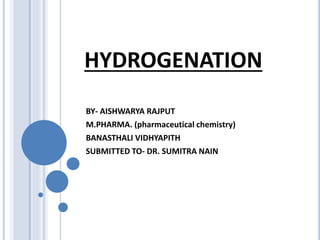
Hydrogenation, catalytic hydrogenation
- 1. HYDROGENATION BY- AISHWARYA RAJPUT M.PHARMA. (pharmaceutical chemistry) BANASTHALI VIDHYAPITH SUBMITTED TO- DR. SUMITRA NAIN
- 2. HYDROGENTAION 1. Catalytic Hydrogenation 2. Homogenous and heterogeneous catalytic hydrogenation 3. Mechanism of catalytic hydrogenation 4. Advantage and disadvantages 5. Applications
- 3. HYDROGENATION Hydrogenation- it is the catalyzed addition of molecular hydrogen. Example:- hydrogenation using nickel as catalyst, CH3-CH=CH2 + H2 →CH3-CH2-CH3 propene propane Hydrogenation is a chemical reaction between molecular hydrogen and another compound or element, usually in presence of a catalyst such as nickel, palladium or platinum. The process is commonly employed to reduce or saturate organic compound. Non catalytic hydrogenation takes place only at high temperatures. It has three components:- 1) the unsaturated substrate, 2) the hydrogen or hydrogen source, 3) a catalyst. The reduction reaction is carried out at different temperature and pressure depending upon the substrate and the activity of the catalyst. Reduction :- the removal of oxygen or addition of hydrogen or gain of electron.
- 4. CATALYTIC HYDROGENATION Definition- The addition of hydrogen to unsaturated system in the presence of catalyst or addition of molecular hydrogen, as an reduction on metal. Almost all alkenes can be saturated in very high yield by treatment with hydrogen and a metal catalyst. WHAT IS THE NEED OF CATALYST? The reduction of alkenes with molecular hydrogen does not occur at room temperature without a catalyst but often takes place at room temperature if metal catalyst is added. Also the catalyst is able to provide a new pathway for the reaction with a lower free energy of activation.
- 5. CATALYST USED IN CATALYTIC HYDROGENATION REACTION Palladium Adam’s catalyst Raney catalyst Copper chromite Rhodium Ruthenium Triethylamine
- 6. HETEROGENEOUS CATALYTIC HYDROGENATION Palladium- Active form of palladium is obtained from palladium chloride. It is reduced in presence of charcoal or any other solid support on which the metal is deposited in a very finely divided state. Adam’s catalyst- Chloroplastinic acid is fused with sodium nitrate to give a brown platinum oxide which can be stored. When required it is treated with hydrogen to give a very finely divided black suspension of the metal.
- 7. HOMOGENEOUS CATALYTIC HYDROGENATION There are several disadvantages of heterogeneous catalytic hydrogenation:- 1. Lack of selectivity if more than one unsaturated center is present. 2. Double bond migration may occur. 3. Several groups undergo an easy hydrogenolysis may occur. Many of these difficulties could be overcome by homogenous catalytic hydrogenation in which the metal gets replaced by a soluble complex of rhodium or ruthenium and conduct the reduction in homogenous solution. Many soluble catalyst have been used and the more effective include the ones derived from rhodium and ruthenium.
- 8. HOMOGENEOUS CATALYTIC HYDROGENATION The rhodium complex used is (Ph3P)3RhCl called as Wilkinson’s catalyst [tris(triphenylphosphine)chlororhodium]. Wilkinson’s catalyst has an advantage that where olefins and acetylenes get reduced, other common group like C=O, C≡N, NO2 remain unaffected. Thus selective reduction can be carried out. Monsanto acetic acid process:- Monsanto developed the rhodium catalyzed process for the carbonylation of methanol to produce acetic acid. Wacker process:- this is one of the earliest industrial processes developed in Germany for the conversion of ethylene into acetaldehyde. Wacker process is more complex than other catalytic processes. Hydroformylation:- The reaction of an alkene with carbon monoxide and hydrogen, catalyzed by cobalt or rhodium salts to form an aldehyde.
- 9. MECHANISM OF CATLYTIC HYDROGENATION STEP 1- Hydrogen molecules react with the metal atoms at the catalyst surface. The relatively strong H-H σ bond is broken and replaced with two weak metal-H bonds. STEP 2- The π bond of the alkenes interacts with the metal catalyst, weakening its bond. A hydrogen atom is transferred from the catalyst surface to one of the carbons of the double bond. STEP 3- The π bond of alkene interacts with the metal catalyst. A second hydrogen atom is transferred from the catalyst surface forming the alkane. STEP 4-The alkane is released from the catalyst’s surface allowing the catalyst to accept additional hydrogen and alkene molecules.
- 10. STEP 1
- 11. STEP 2
- 12. STEP 3
- 13. STEP 4
- 14. CATALYTIC HYDROGENATION Advantages :- Relatively high specificity. Relatively low reaction temperature. Generally far more selective for a single product. Far more active Disadvantages :- Far more difficult to achieve product / catalyst separation.
- 15. SYNTHETIC APPLICATIONS OF CATALYTIC HYDROGENATION
- 16. SYNTHETIC APPLICATIONS OF CATALYTIC HYDROGENATION
- 17. REFERENCES Chatwal G.R., “Reaction Mechanism and Reagents in Organic Chemistry”,reprint-2003,Himalaya publishing house, page no. 1001- 1009. Kalsi P.S., “Organic Reaction and Their Mechanisms”, New age publication, second addition, page no.- 453-462. https://www.slideshare.net/mobile/SonaliPimple1/hydrogenation- reaction